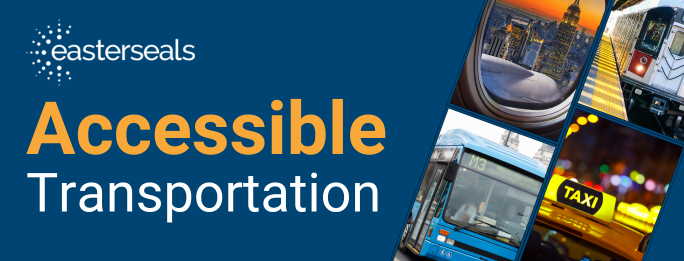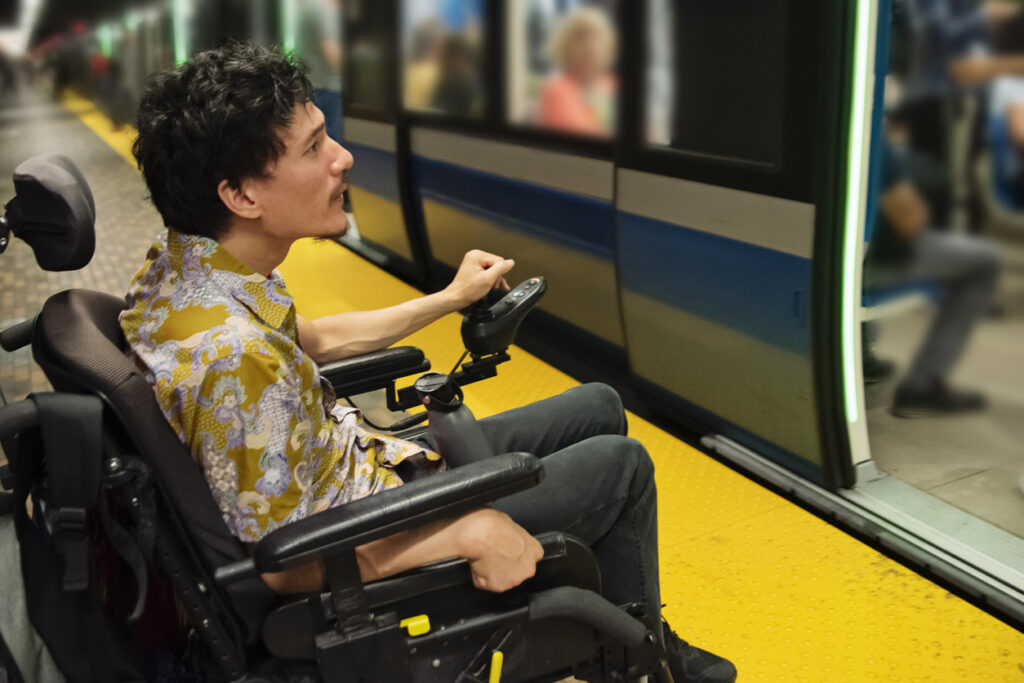Bridging the Gap in Public Transportation for Disabled Travelers
by Blog Writers

By Mike Ervin
If you ride public transit trains here in Chicago, at each boarding platform you will see a couple storage boxes made of silver metal. Each of those boxes contains what’s called a gap filler, which is a fiberglass square with wheels on the side. Gap fillers are painted yellow and on each, planted in blue, is the international symbol of wheelchair access and the words WELCOME ABOARD. The gap filler is about five feet tall and four feet wide.
So, whenever I ride the train, I tell my destination to the Chicago Transit Authority (CTA) customer assistant that’s on duty in the kiosk at the station from where I am departing. The CA, as they are called, then escorts me to the boarding platform. Either that or they meet me there. The CA has a big ring of keys and uses one of them to unlock the nearest silver storage box. They roll out the gap filler. When the train arrives and the doors open, the CA puts the yellow slab in place in front of the door to bridge the gap between the station platform and the train and I roll in. After the train leaves and the CA returns to their kiosk, they contact the CA on duty at the station of my destination to let them know I am coming so that they can be waiting to put down the gap filler when my train arrives so I can roll off.
When the Americans with Disabilities Act was signed into law in 1990, it mandated wheelchair access to all public transportation. So the CTA was faced with the challenge of convincing people with disabilities to try riding the newly-accessible buses and trains. Thus, the Joint Implementation Committee (JIC) was formed. JIC members were CTA officials and Chicagoans with disabilities. We met regularly to brainstorm ways to make riding the CTA as smooth as possible for wheelchair users. We knew that the key to getting wheelchair users to try riding was to make them feel welcome. We all agreed that not too many wheelchair users were going to jump on the CTA just because the federal government declared that they had a right to do so. Disabled people were too used to being excluded from the public transit system because of all the physical barriers that kept them out and the reluctance of the CTA to do anything about removing any of those barriers. They needed to be confident that the CTA understood and addressed all of the little details that added up to true accommodation.

Just adding elevators to make train stations and platforms accessible wasn’t enough. When trains pulled up to the platform and their doors opened to let riders in and out, that would create another barrier. The floor of the train would be a few inches higher than the platform. Most people would just step over that gap without giving it a thought. But that gap could prohibit a wheelchair user from boarding the trains.
So the JIC recommended that there be something available at every boarding point that can be deployed to bridge the gap. But there would have to be humans involved because these bridges weren’t going to deploy themselves. It made the most sense that assisting people with disabilities in this way would be one of the job duties of the CA. But what if there was no CA on duty or if they were away from the kiosk assisting somebody else and couldn’t be contacted?
In that case, if there was no CA around and a passenger needed the gap filler to get on or off of the train, it would be the job of the person operating the train to get out of the train and deploy it.
That’s how the gap fillers and the system of deploying then came to be long, long ago. There are a lot of moving parts, which makes it more likely that something will go wrong. But all I can say is that I have ridden CTA trains hundreds of times. And whenever I’ve needed the gap filler, a CA or train operator has always deployed it. It’s become a matter of routine for CTA employees. When someone who uses a wheelchair shows up to ride, everybody knows just what to do.
But one thing that has changed since the ADA became law is that train cars that are much more wheelchair accessible are being manufactured and CTA has put several of them into service. When a train consisting of these cars pulls up and the door opens, the car is usually on the same level as the platform so there’s no need for me to use the gap filler to get on or off.
That’s what happened when I rode a CTA train earlier this summer. As I waited on the platform for the train to arrive, the CA vigilantly stood next to me clutching the yellow gap filler. ready to put it in place. But when the train pulled up and the doors opened, it was one of the newer, more accessible cars. The entrance of the doorway was level with the platform so I really didn’t need to use the gap filler to get on. But before I could say anything, the CA was already putting the gap filler in place. So I just thanked him and rolled on.
When I arrived at my destination, another CA was waiting on the platform with a gap filler. The doors opened and again, before I knew it, she had put it in place.
My return trip went the same way. The train car was one of the new ones so I didn’t need the gap filler to get on or off. But the CAs were always right there to put one in place.
And again, the only thing I said to them was thank you. I didn’t want to say or do anything that might discourage any of them from going the extra mile to make people with disabilities feel welcome riding the CTA.
Mike Ervin is a writer and disability-rights activist living in Chicago. He is a columnist for the Progressive magazine and writes the blog Smart Ass Cripple.






